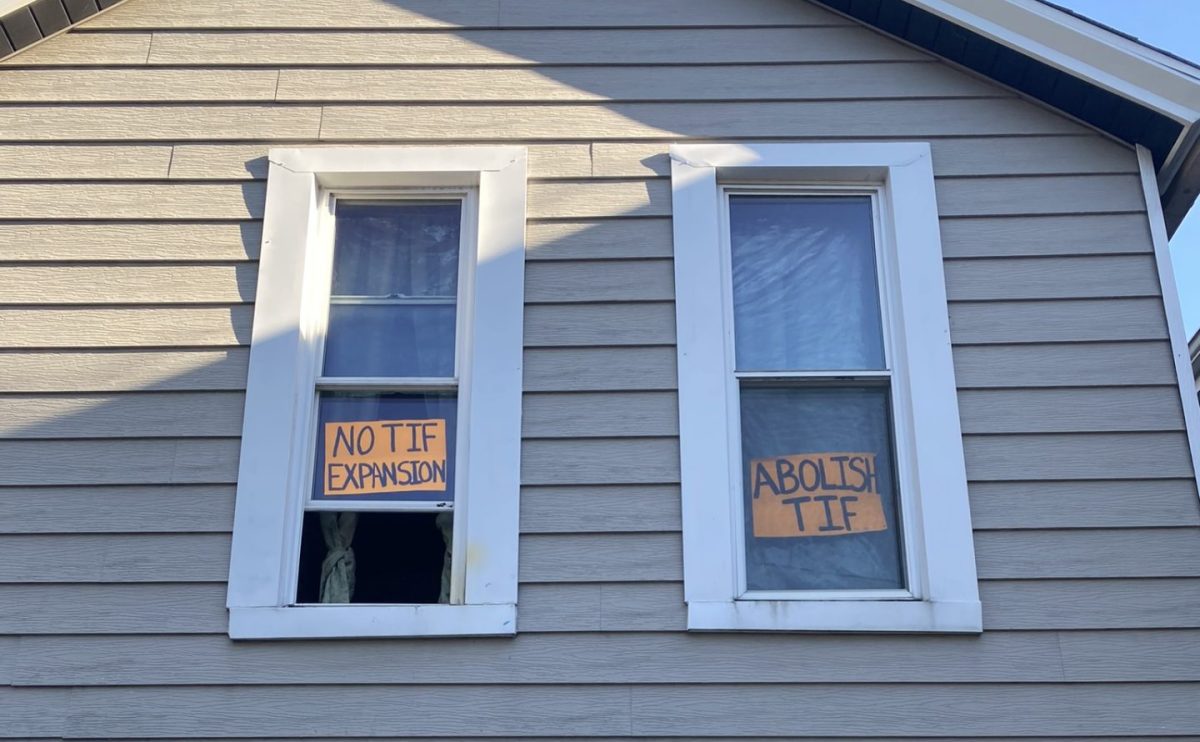Leonardo Quintero, a district councilor for the city of Chicago, has lived in Pilsen all his life. He is also a community activist against Tax Increment Financing (TIF), considering himself a “TIF Abolitionist.”
Signs saying, “Say No to TIF” and “Abolish TIF” hang on the windows outside Quintero’s home.
TIF is a financing tool used by the city to fund public and private investments in what supporters call “blighted” communities. An expansion in the TIF district is being proposed to the entirety of the Pilsen neighborhood, including residential and business areas.
The annual revenue collected and given to a regular taxing body (like Chicago Public Schools, Cook County) is frozen at a determined base amount. The money that exceeds this amount is collected and put into a TIF fund. This extra amount is known as an ‘increment’. The revenue in the taxing body remains stagnant in a district.
The current 907-acre TIF district in Pilsen only functions in the industrial corridor, the area in Chicago designated for industrial and manufacturing use. The Department of Planning & Development (DPD) and Pilsen Alderman (25th Ward) Byron Sigcho López proposed the expansion. While Ald. Sigcho-Lopez is a frequent TIF opponent in other neighborhoods, but he supports TIF expansions in Pilsen.
“People [Chicago mayor and DPD] who have [TIF] money, know how to obtain and access this money. The people who are paying for it, the señora across the street, end up having to subsidize and pay for these corporate welfare and companies, who in response, don’t hire within the neighborhood, or don’t give back in any type of way,” Quintero said.
There’s overall opposition to the expansion by Pilsen activists like Quintero and grassroots social justice organizations like the Pilsen Alliance and Residents against the TIF Expansion. Together they are pushing back on city officials in favor of expanding, like Mayor Brandon Johnson and Ald. Sigcho-López.
TIF opposers say the expansion could contribute to further gentrification, increased property taxes and thus force out long-standing Latino residents in Pilsen.
“[Pilsen residents] basically feel like Pilsen is 90% gentrified right now. If the TIF expansion happens, it’s basically the nail in the coffin to Pilsen,” said Andres Guzman, a Mexican-American activist and Pilsen resident involved with the Pilsen Alliance. This TIF expansion could affect small business owners and homeowners, Guzmán said. He and the Pilsen Alliance have worked for months to rally support against the expansion.

“Nearby areas around the TIF district will have to raise their property taxes to compensate for the loss of funding in public services,” said Guzmán.
Supporters of the expansion say that TIF funding is used to help build and repair infrastructure, clean up pollution and fund community projects, according to the City of Chicago’s website.
Dannielle Jenkins is a Pilsen resident and a personal assistant for the Human Services Department of Rehabilitation at the Resurrection Project.
They are a non-profit organization that provides affordable housing and services for immigrants – both are supporters of TIF and its expansion.
The TIF expansion could make a “huge difference” if approved, because Pilsen residents would have the opportunity to get housing as well as provide tax assistance for homeowners, according to Jenkins.
Jenkins lives with her four children and two grandchildren in Pilsen. Her children attend Joseph Jungman STEM Magnet school, which Jenkins describes as old and in need of repair, having opened its doors in 1902.
“They have a ceiling in one of the bathrooms that is falling in, and they just don’t have the funds to fix these things,” Jenkins said. “They want to provide certain amenities for the students, and different activities, but with no funding, they can’t do it.”
TIF funding from Pilsen’s industrial district has repaired the roof of Manuel Perez Elementary School and built a plaza commemorating Mexican figures in Benito Juarez High School in 2010.
Critics of TIF funding say that Pilsen schools like Ruiz Academy and Benito Juarez High School may benefit from repairs and renovations, but TIF does not cover teachers’ and janitors’ salaries.
Quintero said that “it doesn’t make sense” to have the infrastructure of the building renovated unless you can’t provide quality staff for the school community.
“TIF doesn’t go into those things,” he said.
The Chicago Teachers Union has called on Mayor Johnson’s administration to end all TIFs in the city, according to their website.
“They’re basically taking chunks of revenue from these public services and then giving them crumbs every now and then, whenever they feel like it,” Guzman said.
He believes that TIFs are defunding schools and money shouldn’t be taken out in the first place.
Ald. Sigcho-Lopéz conducted his own town halls to present the TIF expansion for residents at Dvorak Park in September 2024.
The alderman received pushback from community members stating their disapproval of the expansion.
Ald. Sigcho-Lopéz also created a TIF expansion digital ballot in September, for residents to vote on the amendment. Quintero and other Pilsen organizers managed to receive over 1,000 signatures opposing the expansion. They presented this petition on Sept. 13, 2024 to Pilsen’s Committee on Finance, according to Quintero.
Ald. Sigcho-Lopéz responded in a statement on Facebook saying most of the signatures were from people outside Pilsen. The results of the digital ballot have not been released to the public, and the link is still open for residents.
“There’s a clear pushback on this [TIF], people do not want this,” Quintero said after collecting signatures.
Quintero describes the newly constructed condo in front of his house as originally owned by a local family, who had to sell it two years ago. He said the new residents are young professionals who do not participate in the community.
“We used to have block parties that were filled to the brim,” Quintero said. “We had a party last year, it was maybe like 20 kids, about four families now.”
He saw the biggest shift in demographics in Pilsen around 2018. But Quintero and his community have been fighting against it since around 2007. He says the biggest housing difference can be seen from Halsted St to Western Ave, with ‘sporadic condos’ filling the streets.
Eduardo ‘Eddie’ Chavez is a lifelong resident of Pilsen, now living in a 100-year-old house that’s been in his family for generations on Cullerton St. He describes Pilsen as a ‘home for immigrants’ but sees a population of developers changing this dynamic.

Once a property is bought by developers, the building is never going to be owned by a family, Chavez said.
TIF funds are not transparent, Chavez said. Renovations made by TIF only benefit a few, and not the mass population.
Chavez, who wants to get rid of the TIF too, cites that Chicago’s bill for financing is 10% higher than what it normally should be to fund this budget, because TIFs are enacted.
Property taxes are being raised in Pilsen to cover TIF’s ‘slush fund’, according to Chavez. Slush funds are defined as a hidden pool of money held by a company without accountability of oversight.
“These people are thinking of Pilsen as a hot commodity, as an investment, not as a place for them to grow their own family, and that’s what’s missing,” Chavez said.



